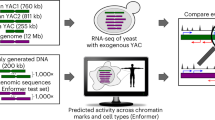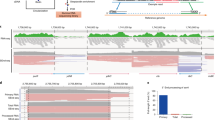Abstract
Antisense long noncoding RNAs (ASlncRNAs) have been implicated in regulating gene expression in response to physiological cues. However, little is known about the evolutionary dynamics of ASlncRNA and what underlies the evolution of their expression. Here, using budding yeast Saccharomyces spp. and Naumovozyma castellii as models, we show that ASlncRNA repertoires have expanded since the loss of RNA interference (RNAi), in terms of their expression levels, their lengths and their degree of overlap with coding genes. Furthermore, we show that RNAi is inhibitory to ASlncRNA transcriptomes and that increased expression of ASlncRNAs in the presence of RNAi is deleterious to N. castellii, which has retained RNAi. Together, our results suggest that the loss of RNAi had substantial effects on the genome-wide increase in expression of ASlncRNAs during the evolution of budding yeasts.
This is a preview of subscription content, access via your institution
Access options
Subscribe to this journal
Receive 12 print issues and online access
$189.00 per year
only $15.75 per issue
Buy this article
- Purchase on Springer Link
- Instant access to full article PDF
Prices may be subject to local taxes which are calculated during checkout




Similar content being viewed by others
Accession codes
Change history
15 April 2016
This article was initially published as an Analysis. The error has been corrected for the print, PDF and HTML versions of this article.
References
Gupta, R.A. et al. Long non-coding RNA HOTAIR reprograms chromatin state to promote cancer metastasis. Nature 464, 1071–1076 (2010).
Rinn, J.L. et al. Functional demarcation of active and silent chromatin domains in human HOX loci by noncoding RNAs. Cell 129, 1311–1323 (2007).
Tsai, M.C. et al. Long noncoding RNA as modular scaffold of histone modification complexes. Science 329, 689–693 (2010).
Lee, J.T. & Bartolomei, M.S. X-inactivation, imprinting, and long noncoding RNAs in health and disease. Cell 152, 1308–1323 (2013).
Houseley, J., Rubbi, L., Grunstein, M., Tollervey, D. & Vogelauer, M. A ncRNA modulates histone modification and mRNA induction in the yeast GAL gene cluster. Mol. Cell 32, 685–695 (2008).
Camblong, J. et al. Trans-acting antisense RNAs mediate transcriptional gene cosuppression in S. cerevisiae. Genes Dev. 23, 1534–1545 (2009).
Camblong, J., Iglesias, N., Fickentscher, C., Dieppois, G. & Stutz, F. Antisense RNA stabilization induces transcriptional gene silencing via histone deacetylation in S. cerevisiae. Cell 131, 706–717 (2007).
Castelnuovo, M. et al. Bimodal expression of PHO84 is modulated by early termination of antisense transcription. Nat. Struct. Mol. Biol. 20, 851–858 (2013).
Necsulea, A. et al. The evolution of lncRNA repertoires and expression patterns in tetrapods. Nature 505, 635–640 (2014).
Brawand, D. et al. The evolution of gene expression levels in mammalian organs. Nature 478, 343–348 (2011).
Hittinger, C.T., Rokas, A. & Carroll, S.B. Parallel inactivation of multiple GAL pathway genes and ecological diversification in yeasts. Proc. Natl. Acad. Sci. USA 101, 14144–14149 (2004).
Levin, J.Z. et al. Comprehensive comparative analysis of strand-specific RNA sequencing methods. Nat. Methods 7, 709–715 (2010).
Byrne, K.P. & Wolfe, K.H.K.P. The Yeast Gene Order Browser: combining curated homology and syntenic context reveals gene fate in polyploid species. Genome Res. 15, 1456–1461 (2005).
Tsankov, A.M., Thompson, D.A., Socha, A., Regev, A. & Rando, O.J. The role of nucleosome positioning in the evolution of gene regulation. PLoS Biol. 8, e1000414 (2010).
Thompson, D.A. et al. Evolutionary principles of modular gene regulation in yeasts. eLife 2, e00603 (2013).
Anders, S. & Huber, W. Differential expression analysis for sequence count data. Genome Biol. 11, R106 (2010).
Warringer, J. et al. Trait variation in yeast is defined by population history. PLoS Genet. 7, e1002111 (2011).
Merkin, J., Russell, C., Chen, P. & Burge, C.B. Evolutionary dynamics of gene and isoform regulation in Mammalian tissues. Science 338, 1593–1599 (2012).
Alcid, E.A. & Tsukiyama, T. ATP-dependent chromatin remodeling shapes the long noncoding RNA landscape. Genes Dev. 28, 2348–2360 (2014).
Yassour, M. et al. Strand-specific RNA sequencing reveals extensive regulated long antisense transcripts that are conserved across yeast species. Genome Biol. 11, R87 (2010).
Rhee, H.S. & Pugh, B.F. Genome-wide structure and organization of eukaryotic pre-initiation complexes. Nature 483, 295–301 (2012).
Neil, H. et al. Widespread bidirectional promoters are the major source of cryptic transcripts in yeast. Nature 457, 1038–1042 (2009).
Xu, Z. et al. Bidirectional promoters generate pervasive transcription in yeast. Nature 457, 1033–1037 (2009).
Drinnenberg, I.A., Fink, G.R. & Bartel, D.P. Compatibility with killer explains the rise of RNAi-deficient fungi. Science 333, 1592 (2011).
Drinnenberg, I.A. et al. RNAi in budding yeast. Science 326, 544–550 (2009).
Lasa, I. et al. Genome-wide antisense transcription drives mRNA processing in bacteria. Proc. Natl. Acad. Sci. USA 108, 20172–20177 (2011).
R Development Core Team. R: a Language and Environment for Statistical Computing. (R Foundation for Statistical Computing, Vienna, Austria, 2013).
Goldstein, A.L. & McCusker, J.H. Three new dominant drug resistance cassettes for gene disruption in Saccharomyces cerevisiae. Yeast 15, 1541–1553 (1999).
Krawchuk, M.D. & Wahls, W.P. High-efficiency gene targeting in Schizosaccharomyces pombe using a modular, PCR-based approach with long tracts of flanking homology. Yeast 15, 1419–1427 (1999).
Cunningham, F. et al. Ensembl 2015. Nucleic Acids Res. 43, D662–D669 (2015).
Cherry, J.M. et al. Saccharomyces Genome Database: the genomics resource of budding yeast. Nucleic Acids Res. 40, D700–D705 (2012).
Parkhomchuk, D. et al. Transcriptome analysis by strand-specific sequencing of complementary DNA. Nucleic Acids Res. 37, e123 (2009).
Sultan, M. et al. A simple strand-specific RNA-Seq library preparation protocol combining the Illumina TruSeq RNA and the dUTP methods. Biochem. Biophys. Res. Commun. 422, 643–646 (2012).
Kiełbasa, S.M., Wan, R., Sato, K., Horton, P. & Frith, M.C. Adaptive seeds tame genomic sequence comparison. Genome Res. 21, 487–493 (2011).
Kim, D. et al. TopHat2: accurate alignment of transcriptomes in the presence of insertions, deletions and gene fusions. Genome Biol. 14, R36 (2013).
Anders, S., Pyl, P.T. & Huber, W. HTSeq: a Python framework to work with high-throughput sequencing data. Bioinformatics 31, 166–169 (2015).
Li, H. et al. & 1000 Genome Project Data Processing Subgroup. The Sequence Alignment/Map format and SAMtools. Bioinformatics 25, 2078–2079 (2009).
Paradis, E., Claude, J. & Strimmer, K. APE: analyses of phylogenetics and evolution in R language. Bioinformatics 20, 289–290 (2004).
Chatterjee, S.N., Devhare, P.B. & Lole, K.S. Detection of negative-sense RNA in packaged hepatitis E virions by use of an improved strand-specific reverse transcription-PCR method. J. Clin. Microbiol. 50, 1467–1470 (2012).
Young, M.D., Wakefield, M.J., Smyth, G.K. & Oshlack, A. Gene ontology analysis for RNA-seq: accounting for selection bias. Genome Biol. 11, R14 (2010).
Acknowledgements
We thank H. Malik, I.A. Drinnenberg and the members of the Tsukiyama laboratory for helpful discussions; H. Malik and I.A. Drinnenberg for critical reading of the manuscript; M. Dunham (University of Washington), D. Bartel (Massachusetts Institute of Technology) and D. Gottschling (Fred Hutchinson Cancer Research Center (FHCRC)) for yeast strains; and A. Marty and FHCRC for sharing resources for deep sequencing. This work was supported by a grant from the US National Institutes of Health (R01 GM058465 to T.T.) and a predoctoral fellowship from the US National Institutes of Health (F31 GM101944 to E.A.A.).
Author information
Authors and Affiliations
Contributions
E.A.A. planned and performed experiments, analyzed and interpreted data, and wrote the manuscript. T.T. planned experiments, interpreted data and wrote the manuscript.
Corresponding author
Ethics declarations
Competing interests
The authors declare no competing financial interests.
Integrated supplementary information
Supplementary Figure 1 Sense RNA expression patterns among budding yeast.
a) Normalized read counts of IPP1 mRNA as measured by RNAseq. (b) as in (a), but for ACT1 mRNA. (c) Principal Component Analysis (PCA) of sense RNA transcriptomes in budding yeast. (d) Neighbor-joining tree of sense RNA transcriptomes based on pairwise distance matrices (Jensen-Shannon distance metric). Highlighted in blue are species of the genus Saccharomyces. Indicated is the bootstrap level between N. castellii and genus Saccharomyces species (out of 100)
Supplementary Figure 2 Pairwise comparisons of sense RNA transcriptomes and ASlncRNA transcriptomes among budding yeast.
(From left to right) (a) Cladogram representing the phylogenetic relationships among budding yeasts; pairwise scatter-plots of sense RNA transcriptomes comprised of 5031 orthologous ORFs for all studied budding yeast species (top), and corresponding Spearman’s rho values (bottom)
(b) as in (a), but for ASlncRNA transcriptomes.
Supplementary Figure 3 Antisense and sense RN-expression differences at tandem and convergent genes in budding yeast species.
(a) Ribbon Plots of antisense read density in log2-scale at genes arranged in convergent (blue) or tandem (pink) orientations for each species analyzed. Antisense read density mapping to the downstream gene has been lightened. (b) Ribbon Plots of sense read density in log2-scale at genes arranged in convergent orientation for (top to bottom) S. uvarum, S. kudriavzevii, S. mikatae, S. cerevisiae. N. castellii is represented in all the plots by the blue ribbon. The lines represent the antisense RNA-seq signal, while the outer borders of the ribbon represent 1 standard-error of the mean away from the mean. (c) As in (b), except for genes arranged in tandem orientation.
Supplementary Figure 4 RNAi constrains Rrp6-dependent transcripts in S. cerevisiae and N. castellii.
(a) Distribution of ASlncRNA levels in wild type S. cerevisiae and N.castellii (SUT-ASlncRNAs) (b) As in (a), but for CUT-ASlncRNAs. See Methods for identification of CUT-ASlncRNAs. (c) Box plots showing the distribution of log2 fold-changes of CUT-ASlncRNAs in an rrp6 background for S. cerevisiae (right) and N. castellii (left). (d) Boxplot representation of the distribution of log2 normalized read counts of ASlncRNAs in the N. castellii rrp6 (left) and rrp6 dcr1 (right) strains for all ASlncRNAs identified in the rrp6 dcr1 mutant (e) as in (d), but for ASlncRNAs with statistically significant steady-state levels.
Supplementary information
Supplementary Text and Figures
Supplementary Figures 1–4 and Supplementary Tables 8 and 9 (PDF 1739 kb)
Supplementary Table 1
RNA-seq libraries and the percentage of reads that map antisense (XLS 31 kb)
Supplementary Table 2
All orthologs shared between N. castellii and Saccharomyces species, with SGD/YGOB gene names (XLS 805 kb)
Supplementary Table 3
ASlncRNAs in S. cerevisiae (XLS 1310 kb)
Supplementary Table 4
ASlncRNAs in S. mikatae (XLS 326 kb)
Supplementary Table 5
ASlncRNAs in S. kudriavzevii (XLS 224 kb)
Supplementary Table 6
ASlncRNAs in S. uvarum (XLS 186 kb)
Supplementary Table 7
ASlncRNAs in N. castellii (XLS 92 kb)
Source data
Rights and permissions
About this article
Cite this article
Alcid, E., Tsukiyama, T. Expansion of antisense lncRNA transcriptomes in budding yeast species since the loss of RNAi. Nat Struct Mol Biol 23, 450–455 (2016). https://doi.org/10.1038/nsmb.3192
Received:
Accepted:
Published:
Issue Date:
DOI: https://doi.org/10.1038/nsmb.3192
This article is cited by
-
Long non-coding RNAs involved in autophagy regulation
Cell Death & Disease (2017)



